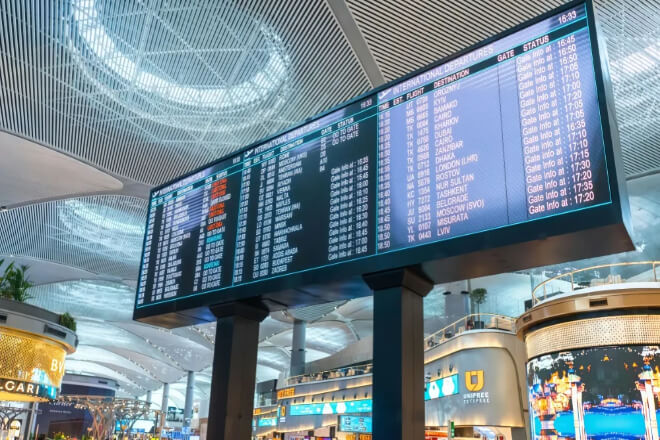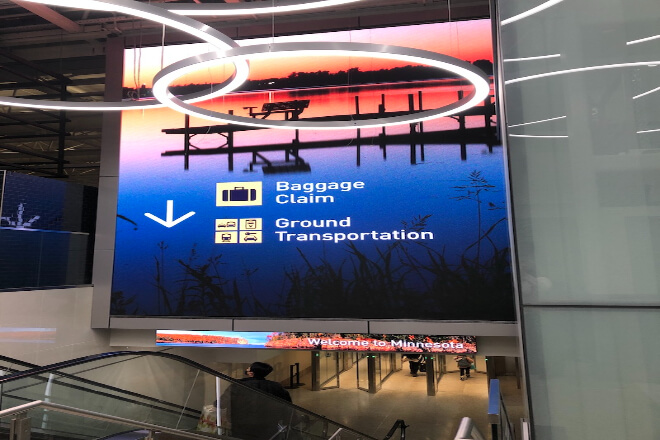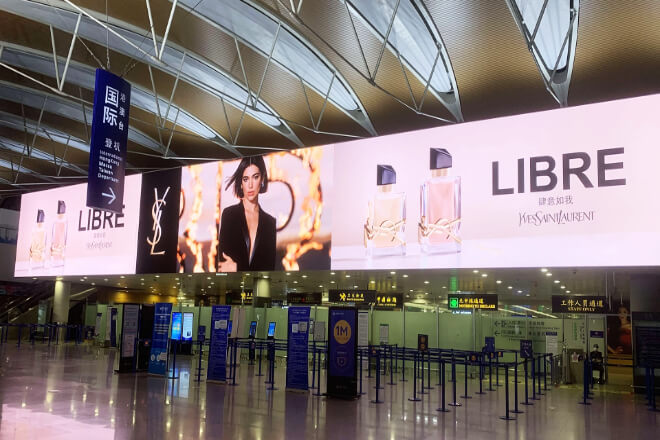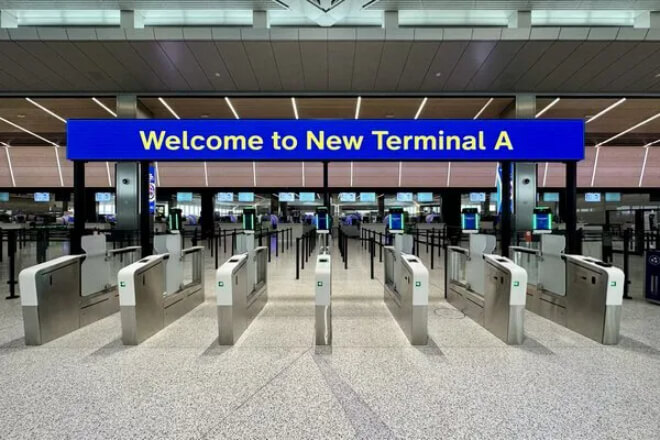Introduction
Imagine the anxiety passengers experience at an airport, facing complex flight information, security queues, and unexpected flight changes.
How can this be made smoother and more efficient? The answer may lie in LED displays.
Today, let’s discuss how LED displays can transform airport passenger flow management and enhance the passenger experience.
Table of Contents
1. Reasons Why LED Displays Can Improve Airport Passenger Flow Management

1) Efficient Information Display
At airports, information must be fast, accurate, and clear. LED displays efficiently display flight information, queue status, and emergency notices.
Flight delays, gate change… all this information is displayed instantly, ensuring you don’t miss anything important.
Whether you’re rushing or leisurely waiting, LED screens ensure you quickly grasp everything, avoiding the “slow-motion” problem of traditional information boards.
2) Real-time Updates and Flexibility
Despite the densely packed airport flight schedules, LED displays support real-time updates, ensuring you always have access to the latest flight, gate, and security information.
3) Visual Impact and Attractiveness
Imagine flight information, notices, or emergency announcements instantly displayed on a large, clear LED screen.
Strong colours and dynamic visuals grab your attention immediately, eliminating the need for anxious searching.
Whether it’s flight information or a sudden emergency, the LED screen communicates clearly and prominently, reducing delays and queues caused by information overload.
4) Multifunctionality and Integration:
Airports require more than just flight information; LED screens can integrate advertisements, news, weather, and other content.
Furthermore, during downtime, the screens can display advertisements or real-time news and weather forecasts.
This allows passengers to easily access flight information and other important data, eliminating the hassle of switching between multiple screens.
5) Visual Impact and Attractiveness:
Imagine flight information, notices, or emergency announcements displayed on a large, clear LED screen.
Strong colours and dynamic visuals grab your attention immediately, avoiding the anxiety of frantically searching for information. Space Saving and Enhanced Interaction
Traditional information boards always take up a lot of space, while LED displays save that space.
Multiple information modules are integrated onto a single screen, resulting in a cleaner and more visually appealing display.
Moreover, an increasing number of LED displays support touch interaction, allowing passengers to directly tap the screen to view detailed information or access personalised services—convenient and intelligent.
2. Application Scenarios of LED Displays in Airport Passenger Flow Management
Whether it’s flight information, security queues, or shopping discounts, LED screens provide passengers with one-stop service.
Let’s take a look at the various application scenarios of LED displays in airports!

1) Flight Information Display
At airports, flight information is a key focus for every passenger. LED displays update flight arrival and departure information, gate information.
And delay notices in real time, ensuring passengers are always aware of the latest flight status.
You no longer need to constantly ask staff or worry about missing your gate; the LED screen will display all the important information to you immediately, helping you plan your trip efficiently.

2) Security and Boarding Queue Guidance
Security checks and boarding queues are always the most anxiety-inducing times at airports.
LED displays can show real-time security check queue information and even guide passengers to the most suitable security checkpoint or boarding gate.
This allows passengers to plan their time in advance, avoiding unnecessary congestion and making the entire flight process smoother and more efficient.

3) Baggage Claim and Transfer Instructions
Baggage claim and transfers are often confusing for airport passengers.
LED displays clearly show the location of baggage claim areas, transfer information, and estimated times, preventing passengers from getting lost or wasting time due to unclear information.
With just a glance at the screen, passengers can easily find the baggage claim area or transfer gate, reducing valuable time wasted due to disorientation.
4) Emergency Notifications and Safety Information
LED displays play a crucial role in emergencies or unexpected situations.
Whether it’s weather changes, flight delays, or other emergencies, LED screens can quickly convey safety tips and emergency measures, keeping passengers informed of the latest situation and allowing them to prepare accordingly.
Fast and effective information delivery not only ensures passenger safety but also prevents panic and chaos.

5) Advertising and Commercial Information
Besides displaying flight information, LED displays are also a great help to airport businesses.
They can be used to publish promotional activities, brand advertisements, and restaurant recommendations for shops within the airport.
Through these advertisements, airports can generate additional revenue streams while also providing passengers with more shopping and dining options. This enhances the shopping experience and brings commercial benefits to the airport.
6) Waiting Areas and Rest Areas
In waiting areas and rest areas, LED displays not only display flight information but also provide passengers with information on dining, shopping, and rest areas.
Want to know where to eat? Or are there any seats available in the rest area? Just a glance at the LED screen can easily help you find a suitable place to pass the time while waiting, improving the overall passenger experience.
3. How do LED displays improve airport passenger flow and passenger experience?

1) Improved Information Transmission Efficiency
Imagine arriving at the airport and seeing a sudden change in flight information. An LED display immediately provides the latest update, eliminating the need to frantically check with staff.
Whether it’s a gate change or a flight delay, LED screens quickly update and display clear information, letting you know immediately and avoiding unnecessary detours, reducing anxiety caused by information delays.
2) Reduced Queuing Time
Queuing is practically standard at airports. However, LED displays help solve this problem.
They dynamically update queue information and security check status, allowing you to keep track of your progress.
For example, LED screens tell you which security checkpoint has the shortest queue and where the longest lines are, enabling passengers to choose the right time and place more wisely, avoiding wasting time in long queues and directly improving efficiency.
3) Enhanced Interactivity
Who says airport information displays are only for passive reception? Modern LED displays not only display flight information but also encourage active passenger interaction.
By using touchscreens or scanning QR codes, passengers can not only view their flights but also access store promotions, restaurant recommendations, and even personalised navigation services.
Want to know where to find the most authentic airport snacks? LED screens let you easily get all the information, eliminating the awkwardness of looking down to search for information!
4) Optimised Passenger Flow Guidance
Airports are often crowded, with queues and congestion being major problems.
LED displays provide real-time traffic updates through intelligent systems, telling you where the crowds are and where the queues are shorter, acting like a mobile “tour guide” for the airport.
This not only helps passengers avoid peak hours but also ensures everyone can move in an orderly manner, reducing unnecessary congestion.
Imagine everyone moving smoothly without the anxiety of missing time or being misled.
5) Enhanced Visual Experience and Comfort
Can airport waiting be more enjoyable? Of course! LED displays offer passengers a unique visual experience through high-definition dynamic content.
For example, the screens can display dynamic city landscapes or art videos, not only conveying information but also providing a beautiful visual feast.
Waiting for your flight shouldn’t be boring; even long waits can become interesting and comfortable, making the waiting time more relaxed and enjoyable for passengers.
4. How to Choose the Right LED Display Solution for Your Airport?

Airports have displays in multiple locations: waiting areas, security checkpoints, and boarding gates, each with different needs.
If you’re in the main hall, standing further away, the information on the large screen needs to be clearer.
However, if you’re at the boarding gate, standing closer, a large screen can be glaring.
Therefore, the screen size and resolution must be selected based on the size of the area and the passenger’s viewing distance.
This ensures clear and logical information display, allowing passengers to see everything at a glance.
Airports are bright places, especially areas with large windows and direct sunlight. If the display brightness is insufficient, information may be difficult to see.
Choose LED displays with high brightness and strong anti-glare capabilities to ensure that passengers can easily read important information.
Such as flight information and boarding gate changes, regardless of how glaring the sunlight may be.
You can think of it as a super display screen that will never be “blocked” by the sun, ensuring it’s visible at every important moment.
Airports are large places with complex passenger flows. Therefore, the layout of LED displays must be tailored to the needs of different areas.
Placing information displays at security checkpoints allows passengers to see queue information; at boarding gates, displaying flight information helps passengers quickly find their gates.
A reasonable layout is like a customised route map for each passenger, ensuring everyone sees the information they need most.
Airport environments are complex, and all equipment must withstand the test, including LED displays.
Airports have high passenger flow, fluctuating temperatures, and the occasional minor impact; therefore, choosing waterproof, dustproof, and shockproof LED displays is crucial.
These robust and durable screens can operate stably in the busy airport environment, reducing maintenance frequency and keeping your displays “always online.”
Managing all the displays in a large airport is no easy task.
Choosing an LED display system that supports remote control and real-time updates allows airport managers to easily adjust the content of all screens through a single platform.
From flight changes to emergency notifications, updates are quick and easy with a single click, making it both efficient and worry-free.
This simplifies airport management, and passengers receive the most accurate information immediately.
5. The Commercial and Operational Value of LED Displays for Airports

1) Improved Operational Efficiency
Airport operations are like a high-speed machine; any delay in any环节 can affect overall efficiency.
LED displays help airport managers optimise workflows and reduce unnecessary passenger wait times and inquiries by providing real-time updates on flight information, gate changes, and security queues.
Regardless of changes in flight information, it can be immediately displayed to passengers, ensuring rapid response at every stage and improving overall operational efficiency.
2) Enhanced Brand Image
Modern airports are not just transportation hubs; they are also important windows showcasing the city’s image.
LED displays enhance the overall image of the airport through clear, efficient, and modern display methods.
Vibrant colours, high-resolution images, and smooth display effects give passengers a strong sense of technology and modernity, thereby enhancing their trust and positive feelings towards the airport.
You can imagine that, standing in a modern airport, a passenger’s first impression will be greatly improved!
3) Increased Commercial Revenue
The application of LED displays is not limited to information display; it also creates considerable commercial revenue streams for airports.
By displaying advertisements and store promotions on LED screens, airports can collaborate with businesses to provide passengers with more shopping and dining options, while simultaneously generating advertising revenue for the airport.
This dual function of “information + advertising” allows airports to diversify their revenue streams beyond solely relying on transportation revenue.
4) Improved Customer Satisfaction
Long wait times are one of the pain points for airport passengers, and the introduction of LED displays has greatly improved this.
It can not only provide real-time flight information and gate changes, but also display information on dining, shopping, and other services in the waiting area, helping passengers manage their time effectively and reducing anxiety.
By reducing information clutter and waiting time, the overall passenger experience is improved, thereby increasing their satisfaction and return rate.
5) Saving Labour Costs
In high-traffic areas like airports, traditional manual guidance often requires a large number of staff. The introduction of LED displays effectively reduces this need.
Passengers only need to check flight information, security queue status, etc., on the screens, eliminating the need to ask staff for assistance, thus saving labour costs.
At the same time, intelligent information systems allow airport staff to focus on more complex issues, improving resource utilisation efficiency.
6. Conclusion
In summary, LED displays are not merely “high-tech decorations” for airports; they play a crucial role in optimising passenger flow, improving information delivery efficiency, and enhancing the passenger experience.
From flight information to security guidance to commercial advertisements, the versatility of LED screens makes airports smarter, more flexible, and more efficient.
Finally, for more information about LED displays, please get in touch with us.
